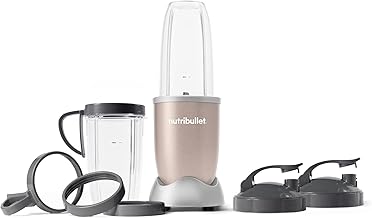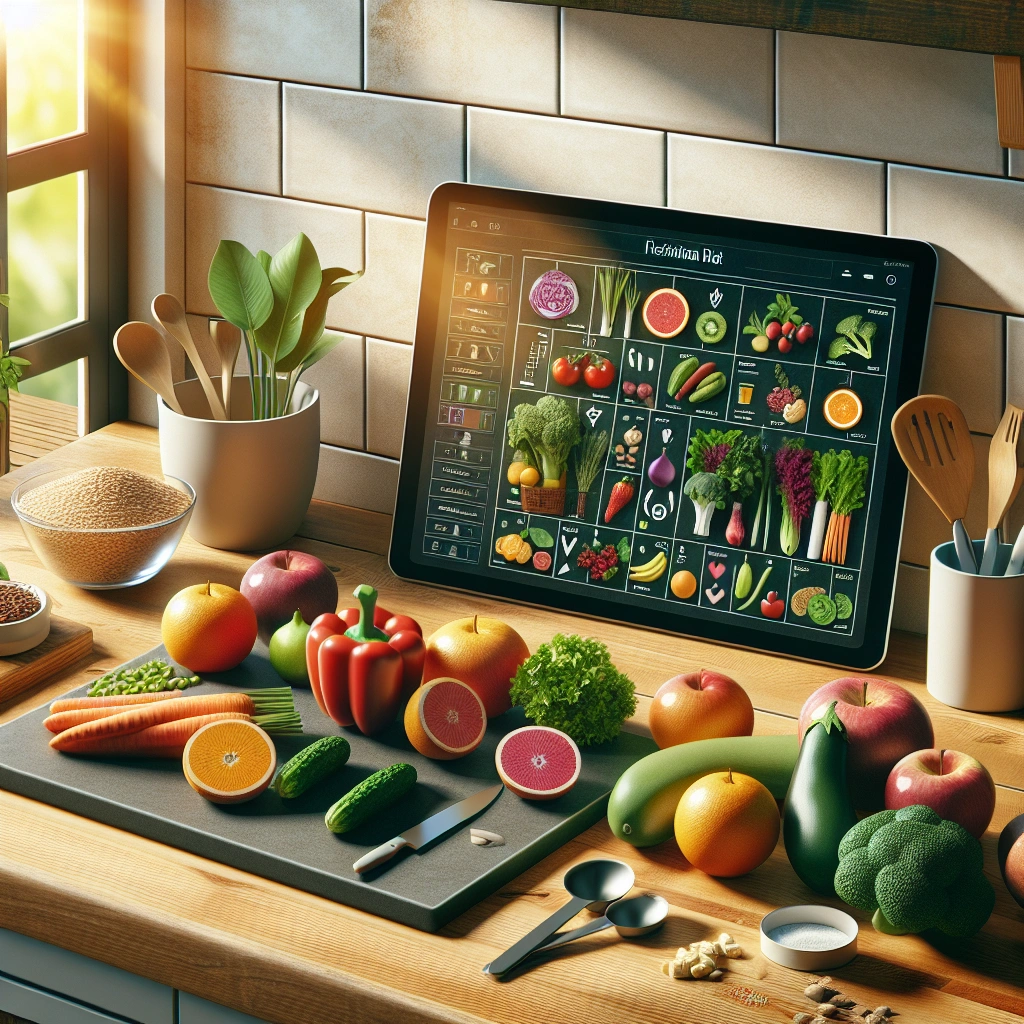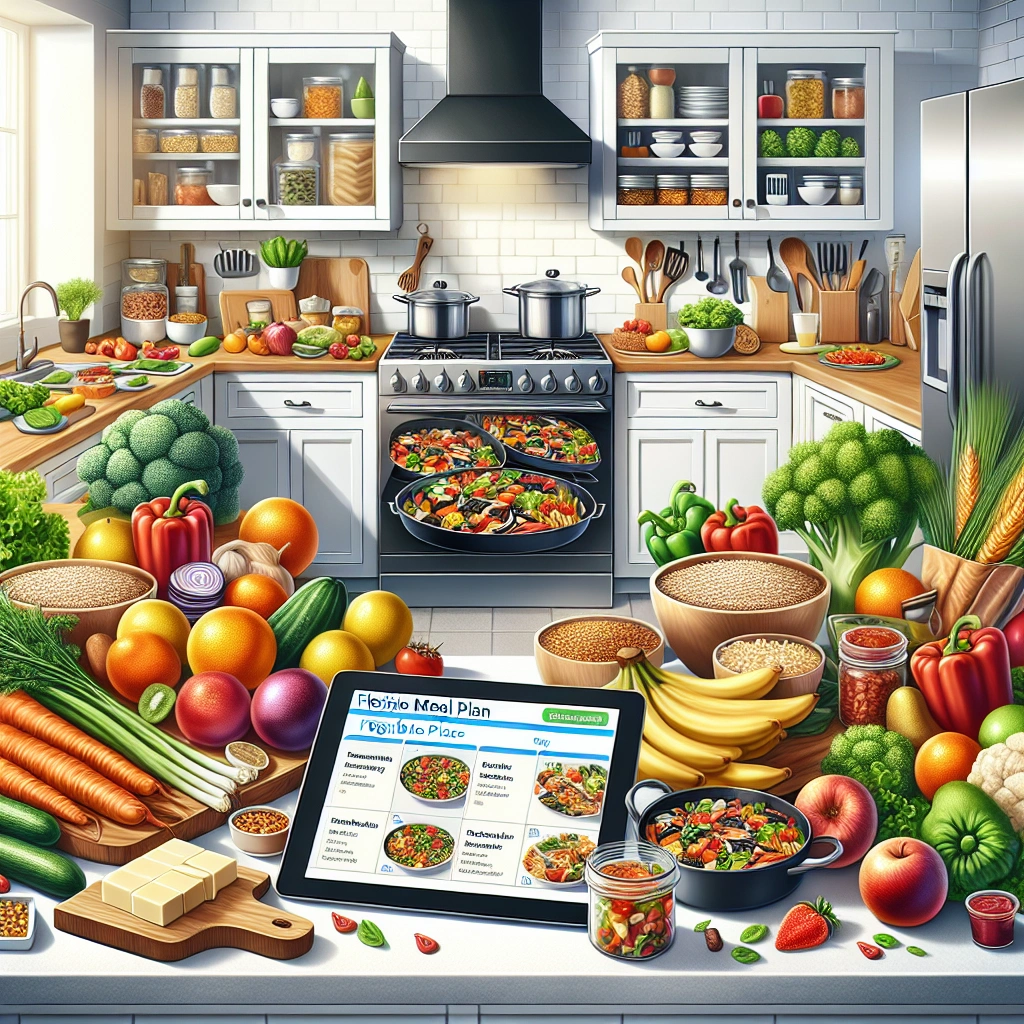

A flexitarian diet is a flexible approach to vegetarianism that focuses on eating mostly fruits, vegetables, legumes, and whole grains, but allows for occasional consumption of meat and animal products. The main purpose of this diet is to slowly increase one’s plant intake over time without omitting animal foods.
Benefits of a Flexitarian Diet include decreased risk of heart disease, weight loss, decreased risk of Type 2 diabetes, and improved markers of metabolic health.
A meal plan is a structured guide for daily meals and snacks, providing a balance of carbohydrates, protein, and fat appropriate for a flexitarian diet. Having a meal plan is important in a flexitarian diet as it helps individuals incorporate a healthy balance of plant-based and animal-based foods.
Check out this Youtube video: If you’re looking for a delicious and easy flexitarian meal plan with simple recipes, this video is a must-watch!
Getting Started with Flexitarian Diet Meal Plan
Understanding the Basics of a Flexitarian Diet
The flexitarian diet is a flexible approach to eating that encourages mostly plant-based foods while allowing for occasional meat and animal products. It emphasizes a gradual increase in plant intake without completely eliminating animal foods.
This approach provides health benefits by focusing on fruits, vegetables, legumes, whole grains, and plant-based proteins. With an emphasis on flexibility, individuals can enjoy the benefits of a vegetarian diet without imposing strict guidelines.
How to Create a Flexitarian Diet Meal Plan
Creating a flexitarian meal plan involves incorporating a variety of plant-based foods such as beans, lentils, tofu, edamame, whole grains, fruits, and vegetables. Meal preparation plays a key role in adhering to this diet, and incorporating recipes that replace meat with plant-based proteins and adding more vegetables can make the transition easy.
Having a 7-day meal plan with a range of recipes can kickstart a healthier approach to eating, offering the flexibility to include animal products while focusing on plant-based options.
Incorporating Flexibility in Your Meal Plan
The flexibility of the flexitarian diet allows individuals to structure their eating habits based on their lifestyle and routine. It is important to choose simple recipes with shorter ingredient lists to make meal preparation more manageable.
By finding new recipes and making swaps to favorite dishes by replacing meat with plant-based protein and adding more vegetables, individuals can seamlessly adapt to the flexitarian lifestyle. This approach ensures that even the most seasoned cooks enjoy an easy, flavor-packed meal plan.
| Flexitarian Diet Meal Plan |
|---|
| Day 1: Breakfast – Muffin-Tin Omelets with Bell Peppers, Black Beans & Jack Cheese |
| Day 1: Lunch – Quinoa Bowl with Black Beans, Veggies & Guacamole |
| Day 1: Dinner – Baked Tofu with Cauliflower Rice and Roasted Vegetables |
Embarking on a flexitarian diet journey involves prioritizing plant-based foods while retaining the flexibility to incorporate animal products. By understanding the basics, creating a meal plan, and integrating flexibility, individuals can transition to this lifestyle seamlessly, enjoying the health benefits of a plant-focused diet.
Remember, it’s all about enjoying a wide range of foods while embracing a more plant-centric approach to eating.
Planning Your Meals
Breakfast Ideas for a Flexitarian Diet
If you’re looking for a delicious and nutritious way to start your day on a flexitarian diet, consider trying out individual frittatas, carrot halwa oatmeal, or a shaved asparagus and frisée salad with warm bacon honey. Incorporating fruits, starchy and non-starchy vegetables, oats, nuts, seeds, eggs, and tofu into your breakfast can provide a variety of flavors and essential nutrients to kick off your morning routine.
Lunch Ideas for a Flexitarian Diet
For a satisfying midday meal, consider preparing a green goddess sandwich, a spinach and artichoke salad with parmesan vinaigrette, stuffed potatoes with salsa and beans, or a tomato, cucumber, and white-bean salad with basil vinaigrette. These options are not only flavorful but also packed with nutrients essential for a balanced flexitarian diet, including a mix of vegetables, beans, and healthy dressings.
Dinner Ideas for a Flexitarian Diet
When it comes to dinner, explore options like slow-cooker Mediterranean stew, beefless vegan tacos, sweet potato and black bean chili, and crispy gnocchi pasta with tomatoes and leeks. These dishes provide a satisfying and hearty meal while aligning with flexitarian dietary guidelines, incorporating a variety of vegetables, legumes, and whole grains to fuel your evening.
Snack Options for a Flexitarian Diet
In between meals, consider snacking on fresh fruits, nuts, seeds, and yogurt to keep your energy levels up and satisfy your cravings. Incorporating these healthy snack options into your flexitarian meal plan can help maintain a balanced diet throughout the day, providing essential nutrients and variety to support your dietary goals.
Flexitarian Diet Meal Plan Recipes
Delicious Plant-Based Recipes
Indulge in a variety of delectable, plant-based recipes that will tantalize your taste buds and nourish your body. From vibrant salads bursting with seasonal produce to hearty vegetable stews and flavorful grain bowls, these recipes celebrate the bounty of nature in every mouthful.
Protein-Rich Meal Options
Explore an array of protein-rich meal options that cater to both vegetarians and flexitarians. From savory tofu stir-fries to protein-packed quinoa harvest bowls, these dishes showcase the incredible versatility of plant-based proteins, ensuring that you meet your daily protein requirements without compromising on taste.
Flavorful and Nutritious Dishes
Immerse yourself in a world of flavorful and nutritious dishes that prioritize both taste and wellness. Whether you savor the earthy goodness of lentil curries or relish the umami flavors of tempeh-based creations, each dish promises to deliver a satisfying and nourishing dining experience for all occasions.
Easy-to-Follow Meal Prep Guide
Simplify your meal preparation with an easy-to-follow meal prep guide designed to streamline your cooking endeavors. With strategic planning and efficient prepping techniques, you can effortlessly incorporate flexitarian meals into your daily routine, ensuring a seamless transition towards a more plant-centric diet.
In every stage of your flexitarian journey, these recipes and meal options open the door to a vibrant and nutritious culinary experience, allowing you to embrace the benefits of a plant-forward approach to eating while savoring every mouthwatering bite. Whether you are seeking to expand your plant-based repertoire or embark on a journey towards a healthier lifestyle, these recipes provide a delightful and satisfying roadmap to culinary fulfillment.
| Recipe | Description |
|---|---|
| Avocado Toast | Satisfying breakfast option with creamy avocados |
| Chickpea Salad | Fresh and filling salad with protein-packed chickpeas |
| Quinoa Harvest Bowl | Wholesome blend of roasted vegetables and quinoa |
| Tofu Stir-Fry | Flavorful stir-fry featuring marinated tofu |
Make a seamless shift towards a more plant-centric lifestyle with these enticing flexitarian recipes that redefine the notion of healthy eating, placing emphasis on flavor, variety, and nutritional abundance.
Importance of PDF Format
PDF format is crucial for delivering structured, professional, and consistent meal plans. It ensures that the meal plan appears exactly as intended, preserving the layout and formatting for user-friendly access.
Tools and Resources
Utilizing Online Recipe Platforms
The internet is teeming with fantastic online recipe platforms where flexitarians can discover a plethora of scrumptious meat-free recipes. Websites such as Cookpad, The Kitchn, and Budget Bytes offer a wide array of flexitarian-friendly recipes that cater to different taste preferences and dietary requirements.
These platforms provide an extensive collection of recipes, including detailed instructions and user reviews, making it easy for individuals to find and experiment with new flexitarian meal ideas.
Cooking Apps for Flexitarian Meal Planning
For those who prefer the convenience of mobile platforms, there are several cooking apps tailored specifically for flexitarian meal planning. Apps such as Green Kitchen and Mealime Pro offer a diverse selection of meat-free recipes and meal planning tools to help individuals organize their flexitarian meals efficiently.
These apps often feature detailed recipe instructions, nutritional information, and customizable meal planning options, making it easier for users to maintain a balanced and varied flexitarian diet.
Meal Planning Templates and Guides
In addition to online platforms and apps, there are various meal planning templates and guides available to assist flexitarians in organizing their meal plans effectively. Websites like Canva and Harvard T. H. Chan School of Public Health offer customizable meal planner templates and comprehensive meal prep guides.
These resources enable individuals to plan their flexitarian meals ahead of time, reduce food waste, and stay organized with their dietary choices.
| Resource | Description |
|---|---|
| Cookpad | Offers a wide array of flexitarian-friendly recipes with user reviews. |
| The Kitchn | Provides a diverse selection of meat-free recipes and meal planning tools. |
| Budget Bytes | Offers numerous flexitarian-friendly recipes catering to different dietary preferences. |
| Green Kitchen | A cooking app with a variety of meat-free recipes and customizable meal planning options. |
| Mealime Pro | Offers detailed recipe instructions, nutritional information, and customizable meal planning options. |
| Canva | Provides customizable meal planner templates. |
| Harvard T. H. Chan School of Public Health | Offers comprehensive meal prep guides to assist with flexitarian meal planning. |
The internet is brimming with valuable tools and resources to support individuals following a flexitarian diet. Online recipe platforms, cooking apps, and meal planning templates and guides provide a wealth of options and assistance in creating and organizing delicious and nutritious flexitarian meals.
Grocery Shopping Tips
Essentials for a Flexitarian Diet
The essentials for a flexitarian diet include prioritizing plant-based foods such as fruits, vegetables, beans, whole grains, nuts, and tofu while allowing for occasional meat consumption. Emphasizing whole grains like brown rice, quinoa, whole wheat pasta, and oats is crucial for energy and fiber intake.
Budget-Friendly Shopping List
Creating a budget-friendly shopping list involves stocking up on delicious and varied plant-based foods. This includes legumes, tofu, edamame, nuts, and seeds, which are affordable and versatile ingredients for a cost-effective flexitarian diet plan.
Making the Most of Seasonal Produce
To make the most of seasonal produce, it’s essential to shop for in-season items to keep produce costs down. Seasonal fruits and vegetables are more nutrient-dense, taste better, and are more affordable.
Additionally, eating seasonally supports local farmers while providing health and environmental benefits.
| Flexitarian Diet Essentials | Budget-Friendly Shopping List | Seasonal Produce Tips |
|---|---|---|
| Plant-Based Foods | Legumes | Shop for in-season items |
| Whole Grains | Tofu | Keep produce costs down |
| Nuts and Seeds | Edamame | More nutrient-dense |
| Nuts | Health and environmental benefits | |
| Supporting local farmers |
These tips will help you navigate grocery shopping effectively for a flexitarian diet, ensuring a balanced and budget-friendly approach to healthy eating.
Meal Prep and Cooking Techniques
Time-Saving Meal Prep Tips
Tip 1: Shift Your Mindset – View cooking as an investment in your health rather than a chore. This shift in mindset can make the process more enjoyable and less time-consuming.
Tip 2: Start Small – Begin with simple meal preps to avoid overwhelm and gradually expand your repertoire as you become more comfortable with the process.
Tip 3: Organize Your Fridge – Keep your refrigerator organized to easily locate prepped ingredients and avoid wasting time searching for items.
Tip 4: Make a Meal Schedule – Plan your meals for the week and allocate specific days for meal prepping, making the process more structured and efficient.
Tip 5: Prep Your Produce Right Away – Wash, chop, and store your fruits and vegetables immediately after purchase to avoid last-minute prep during cooking.
Tip 6: Make Breakfast the Night Before – Prepare breakfast items the night before to ensure a healthy and time-saving start to your day.
Cooking Methods for Flexitarian Recipes
Technique 1: Baking – Utilize baking as a healthy cooking method to retain nutrients and enhance flavors in flexitarian recipes.
Technique 2: Roasting – Roasting ingredients imparts a rich flavor and caramelization, adding depth to your flexitarian dishes.
Technique 3: Sautéing – Opt for sautéing with minimal oil to create delicious and nutritious flexitarian meals.
Technique 4: Stir-frying – Stir-frying allows for quick cooking of vegetables and proteins, maintaining their textures and preserving nutrients.
Technique 5: Boiling – Boiling is a versatile method suitable for cooking grains, legumes, and vegetables, ensuring a nutritious and filling result.
Incorporating Variety in Your Meals
Idea 1: Spice Things Up – Add a variety of spices and herbs to your dishes to enhance flavors and create diverse taste experiences.
Idea 2: Add More Color to Your Dish – Incorporate a colorful array of fruits and vegetables to make your meals visually appealing while ensuring diverse nutrient intake.
Idea 3: Get Creative With Leftovers – Repurpose leftover ingredients to create new and exciting dishes, minimizing food waste and maximizing variety.
Idea 4: Try Something You’ve Never Cooked Before – Challenge yourself to experiment with new ingredients and recipes, expanding your culinary repertoire and infusing excitement into your meals.
| S/N | Cooking Method | Description |
|---|---|---|
| 1 | Baking | Retains nutrients and enhances flavors |
| 2 | Roasting | Imparts rich flavor and caramelization |
| 3 | Sautéing | Creates delicious and nutritious meals |
| 4 | Stir-frying | Preserves textures and nutrients |
| 5 | Boiling | Suitable for grains, legumes, and vegetables |
These time-saving meal prep tips and cooking methods for flexitarian recipes will not only simplify your cooking routines but also contribute to a more diverse and nutritious meal plan.
Nutritional Considerations
Ensuring Adequate Protein Intake
To ensure adequate protein intake on a flexitarian diet, aim for around 0.75g of protein per kilogram of body weight per day. This translates to approximately 45g for women and 55g for men.
Foods such as meat, fish, nuts, and tofu can provide the required protein portions. It is advisable to consume 15–30 grams of protein at each meal to maintain a balanced intake.
Balancing Macro and Micronutrients
Achieving a balance of macro and micronutrients is crucial for overall health. Macronutrients like protein, fat, and carbohydrates provide energy, while micronutrients such as vitamins and minerals support metabolism and various bodily functions.
Opting for nutrient-dense, minimally processed foods that encompass fruits, vegetables, whole grains, lean proteins, and healthy fats ensures an appropriate balance of both macro and micronutrients.
Supplements for a Flexitarian Diet
Individuals following a flexitarian diet should consider supplementing with nutrients that are commonly lacking in plant-based diets, such as algal oil or fish oil to ensure optimal EPA/DHA levels. Additionally, paying attention to nutrients like protein, iron, vitamin B12, omega 3, calcium, and zinc is vital for maintaining a well-rounded flexitarian diet.
Incorporating Flexibility
Flexibility isn’t just about physical health; it’s about treating yourself with indulgent meals to maintain a balanced approach. Indulgent meals can be incorporated into a flexitarian diet meal plan by allowing occasional enjoyment of favorite foods.
Adjusting to different lifestyles and schedules is key; it’s all about balance.
Maintaining a balanced approach is essential to the flexitarian diet meal plan. It involves understanding that indulgent meals are part of a healthy lifestyle.
Flexibility isn’t just about the body; it’s about the mind too. So, indulge sensibly and maintain a balanced approach to achieve the best results.
Staying Motivated
Feeling motivated can be tough, but setting realistic goals can help. Start by setting one specific, achievable goal that aligns with your Flexitarian lifestyle.
Break it down into small, easy tasks and set regular reminders to keep you on track. This could be integrating a new vegetable into your meals or cooking two meatless dinners per week.
Embracing the Flexitarian lifestyle is a journey, and setting realistic goals will keep you motivated along the way. Aim to make these changes in a timeframe that feels manageable for you, whether it’s one week or one month.
Remember, every step you take towards a more Flexitarian lifestyle is a step in the right direction. A supportive environment is key to staying motivated.
Surround yourself with individuals who align with your goals and can encourage and inspire you. This might mean finding a like-minded community online or enlisting the support of friends and family.
Having a strong support system can make all the difference on your Flexitarian journey.
Embracing the Flexitarian lifestyle means embracing a balance between plant-based and animal products. This approach offers flexibility and sustainability, making it easier to stick with in the long run.
As you embrace this lifestyle, remind yourself of the health benefits, environmental impact, and ethical considerations that motivate you to make these changes. Keep these reasons at the forefront of your mind as you navigate the Flexitarian path.
| Realistic Goal | Supportive Environment | Flexitarian Lifestyle |
|---|---|---|
| Cook 2 meatless dinners per week | Join an online Flexitarian community | Balance plant-based and animal products |
Tracking Progress
To monitor your health and wellbeing on a flexitarian diet meal plan, it’s crucial to track various aspects such as your weight, body measurements, and food intake. Tools like fitness trackers, food journals, and blood pressure apps can help in keeping tabs on your progress and ensuring that you stay on the right track.
Monitoring Your Health and Wellbeing
Monitoring your health and wellbeing involves regularly checking vital signs, such as blood pressure, cholesterol levels, and overall fitness progress. Furthermore, keeping a food diary to track your meals, water intake, and calorie consumption can provide valuable insights into your dietary habits.
It’s like having your own personal health assistant helping you stay on top of your wellness goals.
Celebrating Achievements and Milestones
Celebrating achievements and milestones on a flexitarian diet is essential for maintaining motivation and boosting morale. Whether it’s reaching a weight loss goal, mastering a new healthy recipe, or completing a fitness challenge, acknowledging these milestones can be incredibly rewarding.
By recognizing and celebrating these achievements, you reinforce positive behaviors and foster a sense of accomplishment.
Reflecting on Your Flexitarian Journey
Reflecting on your flexitarian journey allows you to look back and assess your progress. It’s about evaluating the challenges you’ve overcome, the changes you’ve embraced, and the overall impact of the flexitarian diet on your life.
Reflecting on this journey can provide valuable insights into your growth, helping you appreciate how far you’ve come and inspiring you to continue your healthy lifestyle.
Expert Insights
Advice from Nutritionists and Dietitians
The flexitarian diet, a blend of “flexible” and “vegetarian,” focuses on plant-based foods while allowing occasional meat consumption. Nutrition experts recommend prioritizing fruits, vegetables, legumes, and whole grains, replacing meat with these wholesome options.
Dietitians emphasize the importance of flexibility in incorporating meat and animal products in moderation to achieve a balanced diet that promotes overall health and well-being.
Success Stories from Flexitarians
Many individuals have embraced the flexitarian diet with remarkable success. By predominantly consuming plant-based foods and integrating occasional meat, flexitarians have experienced improved health, sustainable weight loss, and enhanced fitness.
These success stories highlight the effectiveness of a flexitarian meal plan in achieving dietary goals while enjoying a diverse range of delicious and nutritious foods.
Common Challenges and How to Overcome Them
One common challenge for flexitarians is finding the right balance between plant-based and animal product consumption to meet nutritional needs. To overcome this, experts recommend thoughtful meal planning, diversifying food choices, and seeking guidance from dietitians to ensure a well-rounded intake of essential nutrients.
Additionally, incorporating a variety of whole, unprocessed foods such as fruits, vegetables, plant-based fats, proteins, legumes, and whole grains is crucial for maintaining a healthy and balanced flexitarian diet.
Addressing Common Concerns
Debunking Myths About Flexitarian Diet
The flexitarian diet is often misunderstood as simply being a vegetarian diet with occasional meat consumption. However, this is a myth.
In reality, the flexitarian diet emphasizes a predominantly plant-based approach, allowing for the occasional inclusion of meat, making it a flexible and sustainable dietary choice.
Addressing Criticisms and Misconceptions
One common criticism of the flexitarian diet is that it may lead to nutrient deficiencies due to reduced meat consumption. However, this is a misconception.
With proper planning and inclusion of a variety of plant-based foods, individuals can meet their nutritional needs while reaping the health and environmental benefits of the flexitarian diet.
Emphasizing the Sustainability of a Flexitarian Lifestyle
Some may question the environmental impact of the flexitarian diet, believing that it may not make a significant difference. In reality, embracing a flexitarian lifestyle can have a substantial positive impact on the environment.
By reducing meat consumption and prioritizing plant-based foods, individuals can contribute to the reduction of greenhouse gas emissions and the conservation of natural resources.
Implementing Sustainability
Sustainability is essential in managing our food choices. When making informed food choices, consider locally grown produce and sustainable food options.
Ensure that the flexitarian diet meal plan includes a variety of fruits, vegetables, whole grains, and plant-based proteins. Be mindful of the carbon footprint and environmental impact of the food selected.
Minimizing food waste is critical in sustainability efforts. Plan meals ahead, utilize leftovers creatively, and consider donating excess food to minimize waste. Additionally, use composting to recycle organic waste, and store food properly to prolong its shelf life.
Support for local and sustainable practices is crucial. Opt for locally sourced ingredients, support farmers’ markets, and restaurants committed to sustainability.
Engage with food producers and suppliers that prioritize sustainable practices. This contributes to the community and reduces the environmental impact of the food supply chain.
Implementing sustainability in our food choices entails being conscious of our ecological footprint, reducing food waste, and supporting sustainable practices in our communities. By making these proactive choices, we contribute to a healthier planet and a sustainable future.
| Benefits of Implementing Sustainability |
|---|
| 1. Minimizes environmental impact |
| 2. Supports local communities |
| 3. Promotes a healthier planet |
Recommended Amazon Products for Flexitarian Diet Meal Plan
Here’s a curated list of products that can help you achieve a well-balanced flexitarian diet meal plan with ease. These recommendations are based on functionality, price, and customer reviews.
Instant Pot Duo 7-in-1 Electric Pressure Cooker


The Instant Pot is a versatile kitchen appliance that can help you prepare a variety of meals suitable for a flexitarian diet. With multiple functions including pressure cooking, slow cooking, and steaming, it makes meal preparation efficient and convenient.
This product has received excellent reviews for its durability and performance, making it a highly recommended addition to your kitchen.
| Pros | Cons |
|---|---|
| Versatile functionality | Learning curve for beginners |
| Time-saving meal preparation | Initial investment cost |
| Durable and reliable | Limited capacity for large batches |
NutriBullet Pro – 13-Piece High-Speed Blender/Mixer System


The NutriBullet Pro is a powerful blender that can aid in creating nutritious and delicious smoothies, soups, and other flexitarian-friendly recipes. Its high-speed motor and durable blades ensure thorough blending, while the variety of cup sizes allows for convenient portion control and easy cleanup.
Customers have praised this product for its ability to effectively blend tough ingredients and its user-friendly design.
| Pros | Cons |
|---|---|
| High-speed blending capability | Loud operation |
| Variety of cup sizes included | Limited versatility for complex recipes |
| Easy to use and clean | Limited capacity for large batches |
Spiralizer 7-Blade Vegetable Slicer


A spiralizer is an excellent tool for incorporating more plant-based meals into your flexitarian diet. This specific 7-blade model offers versatility in creating various vegetable noodle shapes, adding creativity and diversity to your cooking.
Users appreciate the sturdiness and ease of use of this product, making it a valuable addition to your kitchen arsenal.
| Pros | Cons |
|---|---|
| Accommodates various vegetable shapes | Storage space required for multiple blades |
| Sturdy and durable construction | Learning curve for blade assembly |
| Enhances meal variety and creativity | Manual operation requires effort |
Simply Calphalon Nonstick Cookware Set, 10 Pieces


A reliable set of nonstick cookware can significantly assist in the preparation of healthy and flavorful meals for a flexitarian diet. This 10-piece set from Calphalon provides essential pots and pans for different cooking techniques, ensuring even heat distribution and easy food release.
With positive customer feedback on its durability and ease of cleaning, this cookware set is a practical choice for everyday use.
| Pros | Cons |
|---|---|
| Even heat distribution | Nonstick coating may wear over time |
| Easy food release | Hand wash recommended |
| Sturdy and reliable | Limited longevity of nonstick coating |
Top Recommended Product for Flexitarian Diet Meal Plan
If you’re looking for the best solution to enhance your flexitarian diet meal planning, we highly recommend the Instant Pot Duo 7-in-1 Electric Pressure Cooker. Here’s why: The Instant Pot offers versatile functionality, time-saving meal preparation, and high durability.
Ready to improve your flexitarian meal planning? Check out the Instant Pot Duo today for the best results!
Conclusion
The flexitarian diet meal plan pdf provides a flexible and sustainable approach to incorporating plant-based foods into one’s diet. This allows individuals to reap the health benefits of a primarily vegetarian diet, while still being able to enjoy animal products in moderation.
Additionally, the meal plan pdf offers a variety of delicious and nutritious recipes that are easy to follow and prepare. This ensures that individuals following the flexitarian diet can enjoy a diverse range of meals without feeling restricted or deprived.
The flexitarian diet meal plan pdf is a practical resource for individuals looking to transition to a more plant-based diet, while still allowing flexibility and enjoyment of a wide range of foods. This approach promotes long-term health and sustainability, making it a viable option for many individuals looking to improve their overall well-being through dietary choices.















